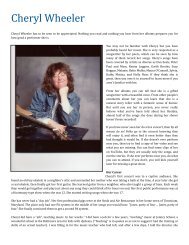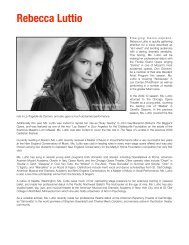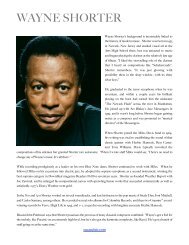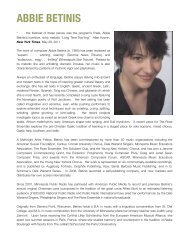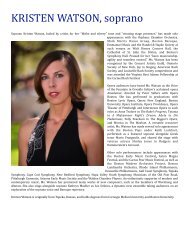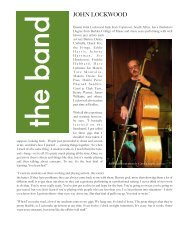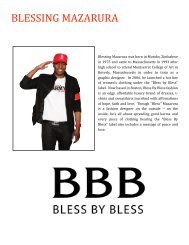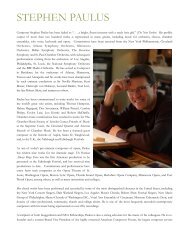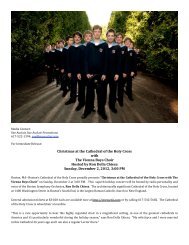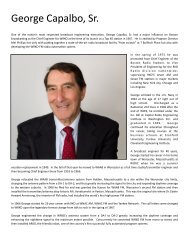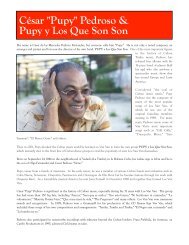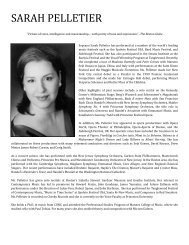Pat Metheny What's It All About Track-by-track - Sue Auclair ...
Pat Metheny What's It All About Track-by-track - Sue Auclair ...
Pat Metheny What's It All About Track-by-track - Sue Auclair ...
Create successful ePaper yourself
Turn your PDF publications into a flip-book with our unique Google optimized e-Paper software.
<strong>Pat</strong> <strong>Metheny</strong><br />
What’s <strong>It</strong> <strong>All</strong> <strong>About</strong><br />
<strong>Track</strong>-<strong>by</strong>-<strong>track</strong><br />
Although the baritone guitar is<br />
featured, appearing on seven of<br />
What’s <strong>It</strong> <strong>All</strong> <strong>About</strong>’s 10 <strong>track</strong>s,<br />
there are some other instruments<br />
represented on the disc.<br />
The record begins with “The Sound<br />
of Silence” which is played on the<br />
42-string “Pikaso” guitar, another<br />
Linda Manzer creation. “<strong>It</strong> is a song I<br />
have always loved. I am a huge fan of Paul Simon in general. I had been experimenting with a way to play this piece<br />
on the Pikasso for a while. The challenges of keeping everything going on that guitar are significant, and the material<br />
needs to lend itself to that axe to make it work. In fact, at the core of that instrument is a six string guitar that for<br />
years I have had in the same baritone tuning that I used on One Quiet Night (that is where the bass notes come<br />
from). This is one of the few tunes on the record where I stay in one key for the whole tune and the way I have that<br />
instrument set up is ideal for that kind of an approach.”<br />
The record continues with “Cherish,” <strong>by</strong> the group The Association. “This was a huge hit in the late 1960s. That<br />
group always had tunes with lots of chords and lots of harmony in the vocals. One day I started playing around with it<br />
and while under the hood of the tune I found myself marveling at all the interesting moves that happen with the<br />
chords, especially on the bridge. And I used the same whole-step modulation for the final A section of the song that<br />
was on the record, although I added a tag that is really not exactly derived from any obvious single point in the tune”.<br />
The centerpiece of the album and the de facto title piece is probably the most famous song of the Burt Bacharach<br />
canon, “Alfie.”<br />
“You can count me in with the millions of people who love that song. <strong>It</strong> is one of my favorite ballads of all time and I<br />
have always wanted to record it. This version has at least four modulations along the way, I just kept shifting it around<br />
to enhance that ever-rising feeling that makes the tune such a classic harmonically.”<br />
This performance of “Alfie” will certainly go down as one of <strong>Metheny</strong>’s finest recorded performances, with an<br />
improvised solo on the form of the song that is unique to his discography. While his usual melodic flair is in focus,<br />
there is a richness to the harmonic choices that makes it seem almost pianistic.<br />
“For me, the baritone guitar offers some real opportunities to explore. And while playing solo is not something that I<br />
focused on in the early going of my life as musician, in recent years I have found a kind of freedom in it. I can set up<br />
pedal points and move around in all 12 keys freely regardless of the form without worrying about other performers<br />
having to follow me. The performance of ‘Alfie’ on the record is an example of that approach”.
Next up is the 1963 hit <strong>by</strong> the Chantay’s, “Pipeline.” “Although my early days as a rocker were short (within a month<br />
or so of taking up the guitar I had discovered Miles Davis and become a jazz guy), I always thought surf music was<br />
sort of a perfect orchestrational use of the electric guitar. At summer camp that year (1963), there was a kid who<br />
could play “Pipeline” and I got him to teach it to me. That was really my introduction to the feeling of holding a guitar<br />
in my hands. This version of it is pretty far removed from the original, however.”<br />
With multiple meter changes and a completely reworked bridge (although faithfully based on the chords of the<br />
original) it is an impressionistic vista of the source material rather than a copy. Why did <strong>Metheny</strong> choose to play this<br />
<strong>track</strong>, and this <strong>track</strong> only, on a conventional acoustic steel string guitar?<br />
“The baritone guitar is fantastic, but sometimes the low pitches take a while to get moving. I wanted to have at least<br />
one thing on the CD that had the kind of tempo represented here, a more strumming kind of thing, and “Pipeline” fit<br />
the bill perfectly. Plus, if you are going to play “Pipeline” in the first place, it sort of has to be in the key of E. There is a<br />
law about that, I believe,” he laughs.<br />
“Pipeline” is the most overtly energetic <strong>track</strong> on the CD. Did <strong>Metheny</strong> intend this to be a “ballads” album?<br />
“Actually, I didn’t really think much about that as I was recording, I just picked songs that I loved and started playing<br />
them. There was a point along the way where I noticed that they were all kind of in ballad territory, but I didn’t really<br />
worry much about it. I just kind of followed my instincts and felt that in the end there would be quite a variety of<br />
composers and songs represented and that it would take on an identity of its own. My record Beyond the Missouri<br />
Sky was similar in that there were only a few obvious moments of faster tempos, but there was still a kind of intensity<br />
to the whole thing. This reminds me of that one in that way.”<br />
The record continues with one of the most famous popular songs of the 20th century, Antonio Carlos Jobim’s<br />
“Garota De Ipanema,” known in English as “The Girl From Ipanema.”<br />
“People are often surprised to hear that this is one of the first songs I ever learned, but any beginning guitar student<br />
knows about the dreaded F chord—the first time you are asked to ‘barre two strings together with one finger. For me,<br />
in that first week of playing the instrument, it was impossible to make my fingers do that. But <strong>by</strong> leaving the top string<br />
open and not doing the barre, you wind up with an F Major seventh chord, which somehow I recognized as being the<br />
first chord of the tune I had just heard Astrud Gilberto sing with Stan Getz on TV around that time. I actually liked it<br />
better than the straight F chord anyway!”<br />
But <strong>Metheny</strong>’s version of “The Girl from Ipanema” is far from anything that would ever be seen or heard on TV. This is<br />
an extremely radical reworking of the iconic piece, almost to the point of being unrecognizable at first, with a tempo<br />
that verges on the subterranean.<br />
“<strong>It</strong>’s true that this is quite a different way of thinking about this piece. I wanted to look at from a whole other point of<br />
view in every way. <strong>It</strong> is a tune that we all know, but to me there was always a darker strain to it somewhere, especially<br />
the amazing shape of the bridge. I just tried to follow the hidden curves.”<br />
Things come back to something closer to home with the Paul Williams composed hit “Rainy Days and Mondays.”<br />
“There are at least 10 Carpenters songs I could have done. Karen’s voice has always been a model for me and her<br />
phrasing has always been an inspiration. And I have always loved the descending/ascending bass line thing that<br />
happens here. I kind of took some liberties with that basic idea but kept it mostly as is.”<br />
Staying with iconic female vocalists of the 70s, <strong>Metheny</strong> continues with Carly Simon’s first major hit “That’s the Way<br />
I’ve Always Heard <strong>It</strong> Should Be.”<br />
“To me, there were always several interesting things about this piece, not the least of which is the way that she<br />
moves from root minor key to the major key just a half step above it so effortlessly in a way that is almost invisible.<br />
But also, I always just thought it was a great melody, with that big leap at the end of the first phrase. And form wise,
the way it goes through this whole thing and then starts back up again to make the same build again. My take on it<br />
harmonically colors in some of what I always thought was implied in there.”<br />
Henry Mancini played a big part in the <strong>Metheny</strong> family. “My parents were major Mancini fans. I think they had all his<br />
records.” The record continues with “Slow Hot Wind” from the mentioned Mr. Lucky TV sound<strong>track</strong>.<br />
“Actually, I was sure ‘Slow Hot Wind’ was from the Hatari (a Mancini movie score) sound<strong>track</strong>, but I realize now that I<br />
must have heard it on one of my parent’s Best of Mancini records or something. I have always loved that song. The<br />
top 40 version of Brazil ‘66 was also a great moment for radio, with that great bridge actually working its way into<br />
mainstream consciousness.”<br />
Here <strong>Metheny</strong> plays the song fairly straight in one of the more conventional performances on the record. But as on so<br />
many <strong>track</strong>s of this compilation, one gets the feeling of multiple parts and multiple layers even in these purely solo<br />
performances. Did he ever think about overdubbing?<br />
“I certainly have no resistance to the idea of using the recording process in the most effective way to serve the music.<br />
But in this case, I really wanted to keep it simple—one guitar, one player, as was the case on One Quiet Night. There<br />
are no overdubs on the record. But where this one differs from One Quiet Night is that I really focused on each tune<br />
along the way. Sometimes I would sit and think about each piece for hours before hitting the record button, practicing<br />
things and imagining a final performance. There are some edits here and there where I found sort of an idealized<br />
version of what I was shooting for, but the idea was to stay true to a particular way of playing and hearing the song<br />
<strong>by</strong> again, keeping the performance aspect of it really simple. There wasn’t any need for any overdubs or multiple<br />
guitar parts. I was able to get to what I wanted just sitting there with the instrument in hand”.<br />
The recording continues with the ‘70s soul hit “Betcha By Golly, Wow.” “Kind of like with the Carpenters, there are<br />
many Thom Bell tunes that I could have done. That is some of my favorite music on the planet”.<br />
The original version was made famous <strong>by</strong> the Stylistics, but <strong>Metheny</strong> takes his inspiration from a different source. “I<br />
always loved this tune in any form, but the Phyllis Hyman version (with Norman Connors Starship) has to be the<br />
definitive one for me. I kind of took the reharmonizations of that version one step further here.”<br />
And the record wraps up with another iconic piece, the Lennon/McCartney classic “And I Love Her,” played here on<br />
nylon string guitar.<br />
“The Beatles were huge for me. Without them, I don’t know if I even would have become a musician or a guitar<br />
player. When their hits started coming out, I was eight and nine years old and it had a tremendous impact on me. I<br />
saw the movie A Hard Day’s Night multiple times when it came out and I always loved that song. <strong>It</strong> is kind of<br />
impossible to imagine doing a record like this without including at least one Beatles song.”<br />
- Greg Santos May 2011




